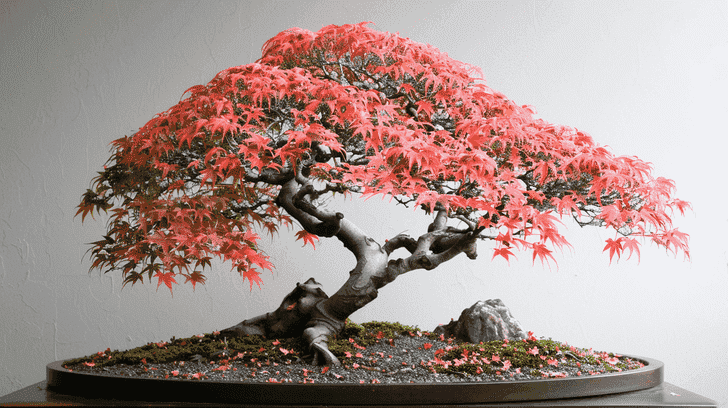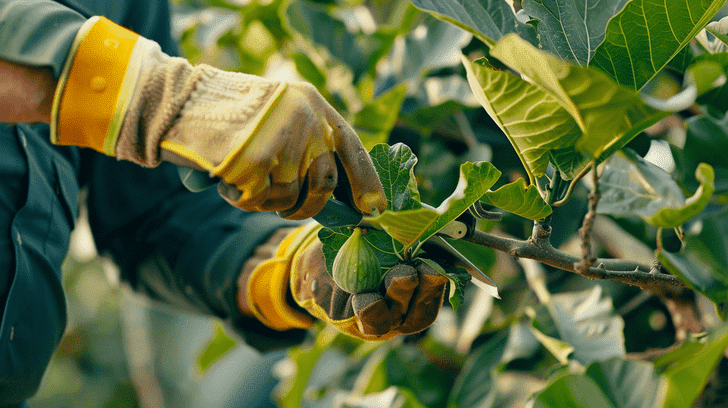Japanese Maple Pruning: A Step-by-Step Guide
As you gaze at your Japanese Maple tree, envisioning its potential for exquisite beauty and graceful form, you may wonder how to expertly prune it to perfection.
With each precise snip of the shears, you hold the power to sculpt and shape this botanical masterpiece.
But how do you navigate the intricate process of pruning without risking the tree’s health or aesthetics?
Stay tuned to uncover the secrets to mastering Japanese Maple pruning, unraveling the step-by-step guide that will elevate your pruning skills to the next level.
Step-by-Step Pruning Process
To begin the pruning process for your Japanese maple, start by carefully inspecting the tree for any signs of damage or disease.
Next, carefully select the branches that need pruning to enhance the tree’s overall health and appearance.
Remember to make precise cuts to promote healing and encourage new growth, ensuring the tree’s balance and symmetry while removing any unwanted suckers or water sprouts.
Inspecting the tree for problem areas
Begin your inspection of the Japanese maple tree by carefully examining its branches and leaves for any signs of disease, damage, or overgrowth that may require pruning.
Start by evaluating the branch structure, looking for any crossing or rubbing branches that could cause wounds. Check for any fungal infections on the leaves or branches, indicated by spots, discoloration, or wilting.
Assess the root health by observing any signs of decay or root circling near the surface. Confirm the tree receives adequate sun exposure and verify soil moisture levels to prevent stress.
This meticulous examination will help you identify problem areas that need attention during the pruning process, ensuring the tree’s overall well-being and health.
Selecting which branches to prune
When determining which branches to prune on your Japanese maple tree, prioritize removing dead or diseased branches first to promote healthy growth and overall tree vigor. Important branch selection is essential in maintaining the tree’s shape and health.
Start by identifying branches that are crossing or rubbing against each other, as they can cause damage and hinder growth. Consider the tree’s overall structure and aim to maintain a balanced appearance by selectively pruning branches that are growing too close together.
Utilize pruning strategies such as branch positioning to enhance the tree’s aesthetic appeal and guarantee proper light penetration. Adhering to pruning guidelines will help preserve branch health and encourage new growth.
Make informed pruning decisions based on branch structure and conduct thorough branch assessment for pruning precision.
Making proper cuts to encourage healing and growth
Consider using a sharp, clean pruning tool to make precise cuts that promote healing and encourage new growth on your Japanese maple tree. When pruning for growth stimulation and promoting overall health, it’s essential to employ proper healing techniques.
Make sure your cuts are clean and smooth to aid in quick healing. Pay attention to pruning angles, as cutting at the correct angle can help the tree compartmentalize the wound effectively.
When selecting branches to prune, focus on removing dead or diseased ones first, followed by any crossing branches that may hinder growth. By making strategic cuts and promoting growth, you set the stage for a beautifully balanced and healthy Japanese maple tree.
Pruning for balance and symmetry
To achieve balance and symmetry when pruning your Japanese maple tree, begin by evaluating the overall shape and structure of the tree. Look at the branch placement to guarantee there’s even spacing and no overcrowding.
Assess the foliage density throughout the canopy, aiming for a uniform distribution to maintain equilibrium. Pay attention to the canopy shape, aiming for a well-proportioned outline.
Consider the growth direction of branches, trimming those that disrupt the tree’s harmony. When pruning for balance and symmetry, utilize proper pruning techniques such as making clean cuts at the branch collar without leaving stubs.
Removing suckers and water sprouts
Evaluate your Japanese maple tree for any suckers and water sprouts that need to be removed to maintain its health and appearance. Removing suckers can benefit the tree by redirecting energy to the main branches, promoting growth and overall health.
Preventing water sprouts is important to avoid rapid, weak growth that can detract from the tree’s natural beauty. When pruning, be mindful of common mistakes like cutting too close to the trunk, leading to potential diseases or decay.
To guarantee the best results, follow proper pruning techniques such as making clean cuts at a slight angle. Shaping the canopy with an artistic touch can enhance the tree’s aesthetic appeal while maintaining its structural integrity.
| Suckers Removal | Water Sprouts Prevention | Pruning Mistakes Consequences | Pruning Techniques Best Practices |
| Redirects energy | Prevents weak growth | Risk of disease and decay | Make clean cuts at a slight angle |
Understanding Japanese Maple Growth
As you begin to explore the growth patterns of Japanese maples, it’s essential to observe their habits closely. By understanding when these trees are in dormant or active growth phases, you can time your pruning efforts effectively.
Recognizing the distinctions between healthy and diseased branches is vital for maintaining the overall health and beauty of your Japanese maple tree.
Growth habits and patterns
Understanding the growth habits and patterns of Japanese maples is essential for successful pruning and maintenance of these ornamental trees. When it comes to pruning techniques, it’s important to be aware of the growth patterns of Japanese maples.
These trees tend to have a delicate branching structure, so proper branch selection is key to maintaining their natural beauty. When making cuts, ensuring that they’re healing cuts is essential for the tree’s health and aesthetics. Additionally, aiming for symmetry balance in pruning helps Japanese maples maintain their graceful appearance.
Identifying dormant and active growth periods
During different stages of the year, Japanese maples go through distinct periods of dormancy and active growth, important for proper timing of pruning and care.
Understanding these growth stages is essential for maintaining the health and beauty of your Japanese maple. By recognizing patterns in the tree’s behavior, you can determine the best times for pruning to promote excellent growth.
During dormancy, typically in late fall to winter, the tree’s growth slows down, making it an ideal time for structural pruning. In contrast, the active growth period, usually in spring to summer, is when the tree is actively producing new growth, making it suitable for fine pruning.
Proper timing ensures the removal of unhealthy branches while preserving the vitality of the tree.
| Growth Period | Description | Pruning Activities |
| Dormant | Late fall to winter | Structural pruning |
| Active | Spring to summer | Fine pruning |
Recognizing healthy versus diseased branches
When evaluating your Japanese maple tree for pruning, your first task is to differentiate between healthy and diseased branches.
Proper branch health assessment is essential for the overall well-being of your tree.
Here are some disease detection tips to help you make informed pruning decisions:
- Look for any signs of discoloration, such as black spots or white powdery residue.
- Check for areas of the branch that appear wilted or have abnormal growth patterns.
- Pay attention to any oozing sap or unusual textures on the branches.
- Inspect for pest infestations or holes that could indicate underlying issues.
Tools and Materials
To properly prune your Japanese maple, you’ll need specific tools and materials. These include essential items like pruning shears, loppers, and a pruning saw.
It’s important to use sharp and clean tools to guarantee clean cuts and minimize the risk of damage to the tree. Additionally, don’t forget to equip yourself with necessary safety gear such as gloves and eye protection to safeguard against potential hazards during the pruning process.
List of necessary tools (e.g., pruning shears, loppers, pruning saw)
You’ll need a set of specialized tools to properly prune your Japanese maple tree, including pruning shears, loppers, and a pruning saw.
When maintaining your tools, make sure they’re sharp and clean to make precise cuts.
To guarantee the health of your tree, inspect branches carefully before pruning and follow proper pruning techniques.
Remember that the frequency of pruning will depend on the growth of your Japanese maple and its desired shape.
Here is a list of essential tools for Japanese maple pruning:
- Pruning shears: Ideal for cutting small branches and twigs.
- Loppers: Useful for thicker branches that pruning shears can’t handle.
- Pruning saw: Necessary for cutting larger branches with precision.
- Gloves: Protect your hands from scratches and irritation during pruning.
Importance of using sharp, clean tools
Using sharp and clean tools is crucial for precise and effective pruning of your Japanese maple tree.
Proper tool maintenance, such as regular sharpening and cleaning, guarantees that your pruning shears, loppers, or pruning saw are in peak condition.
Sharp tools make clean cuts, promoting faster healing and reducing the risk of disease entering the tree.
Safety gear (e.g., gloves, eye protection)
Maintain your safety during Japanese maple pruning by ensuring you have the appropriate safety gear, such as gloves and eye protection, readily available.
When engaging in proper pruning techniques, it’s essential to prioritize safety precautions and use the correct equipment essentials.
Here are key items to keep in mind:
- Protective Gloves: Invest in durable gloves to shield your hands from cuts and blisters.
- Safety Glasses: Wear safety glasses to safeguard your eyes from debris and branches.
- Ear Protection: Consider using ear protection to reduce noise exposure from power tools.
- Sturdy Footwear: Opt for sturdy, closed-toe shoes to prevent injuries from falling branches or tools.
Timing of Pruning

Pruning Japanese maples should be timed carefully to promote healthy growth and shape the tree effectively. Understanding the best timing for pruning is essential to maintain the tree’s beauty and health.
Different seasons offer unique opportunities for pruning, influencing growth patterns and overall tree structure.
When selecting branches for pruning, aim for balanced pruning to maintain the tree’s symmetry and canopy shaping. It’s important to use the right pruning tools and follow safety precautions to prevent damage to the tree and ensure your safety.
Optimal times for pruning
When it comes to pruning your Japanese maple, timing is essential. To guarantee the best results, aim for late winter to early spring for major pruning and reserve summer for minor adjustments.
Avoid pruning during periods of active growth or extreme weather to prevent stress on your tree.
Avoiding pruning during periods of active growth or extreme weather
During periods of active growth or extreme weather, it’s important to avoid pruning your Japanese maple tree to guarantee its health and vitality.
Pruning mistakes made during these critical times can lead to stress and damage to the tree. Consider the following to ensure ideal pruning conditions:
- Weather considerations: Extreme weather conditions can weaken the tree and hinder its ability to recover from pruning cuts.
- Growth patterns: Pruning during active growth phases can disrupt the tree’s natural development and lead to stunted growth.
- Healthy branches: Pruning during these times may compromise the tree’s ability to heal properly, leaving it vulnerable to diseases and pests.
- Pruning tools: Using sharp and clean tools is essential to minimize stress on the tree and promote quicker healing of pruning wounds.
Considerations for pruning newly planted versus established trees
For best results when pruning newly planted versus established Japanese maple trees, late winter to early spring is the ideal time for major pruning. Summer is best suited for minor adjustments.
Proper spacing between branches is essential for ideal sunlight penetration and air circulation, promoting overall tree health.
When dealing with newly planted trees, pay close attention to root health by ensuring they’re well-established before major pruning.
Consider branch angles to maintain a balanced canopy and prevent weak crotches. Evaluate sun exposure to determine if any adjustments are needed to prevent scorching or poor growth.
Additionally, establish a consistent watering schedule, especially for newly planted trees, to support their growth and recovery after pruning. Following these considerations will help your Japanese maple thrive.
Pruning Techniques
When pruning your Japanese maple, make sure to remove any dead, damaged, or diseased branches to promote overall health.
Thinning out overcrowded branches will enhance airflow and light penetration, benefiting the tree’s growth.
Shape the canopy carefully for aesthetic appeal, maintaining the tree’s desired size and form without over-pruning or being too aggressive in your approach.
Removing dead, damaged, or diseased branches
To effectively prune your Japanese maple tree, identify and remove any dead, damaged, or diseased branches using sharp, clean pruning tools. Ensuring branch health is vital for the overall well-being of your tree. Follow these precise steps:
- Inspect the tree: Carefully examine each branch, looking for signs of decay, discoloration, or injuries.
- Cut at the right angle: Make clean cuts close to the branch collar without leaving stubs to promote faster healing.
- Dispose properly: Remove all pruned branches from the area to prevent the spread of diseases.
- Monitor regularly: Regularly check your tree for any new signs of damage or disease to address them promptly.
Thinning out overcrowded branches to improve airflow and light penetration
Consider strategically thinning out overcrowded branches in your Japanese maple tree to enhance airflow and allow better light penetration for ideal growth.
Improving circulation within the tree not only promotes overall health but also reduces the risk of diseases.
By thinning out branches, you enhance light distribution, important for photosynthesis and the tree’s energy production.
Pay attention to the branch structure, removing those that cross or rub against each other to prevent damage.
Airflow optimization is essential for preventing fungal infections and maintaining a healthy canopy.
Proper space management through thinning ensures each branch receives adequate sunlight and nutrients, fostering balanced growth.
Careful thinning of overcrowded branches is a key step in maintaining the health and vigor of your Japanese maple tree.
Shaping the canopy for aesthetic appeal
Shape the canopy of your Japanese maple tree for ideal aesthetic appeal using precise pruning techniques.
When aiming to enhance the appearance of your tree, consider the following canopy shaping techniques:
- Selective Pruning: Target specific branches to create a balanced and visually pleasing canopy.
- Creating Layers: Develop distinct layers within the canopy for a more structured and appealing look.
- Accentuating Form: Emphasize the natural form of the tree through strategic pruning cuts.
- Framing Views: Trim branches to frame beautiful aspects of the tree, such as unique bark patterns or colorful foliage.
Pruning to maintain size and form
Maintain the size and form of your Japanese maple tree through meticulous pruning techniques that guarantee its best growth and structure.
To control size and shape, focus on selective branch pruning to enhance aesthetics and preserve the tree’s natural form.
When pruning, consider the tree’s growth patterns and select branches strategically to promote airflow and canopy management.
Use proper cutting techniques, such as making clean cuts close to the branch collar, to secure quick healing and new growth.
Avoiding over-pruning or pruning too aggressively
To maintain the health of your Japanese maple tree, it’s crucial to be cautious not to overly prune or prune too aggressively, as this can harm its growth and overall health.
When pruning your Japanese maple, it’s vital to follow proper pruning techniques to guarantee its well-being.
Here are some pruning tips to help you preserve the health of your tree:
- Avoid removing more than 25% of the tree’s canopy in a single pruning session.
- Prune selectively, targeting dead, damaged, or crossing branches.
- Do not prune during the late summer or fall to prevent stimulating new growth that may not harden off before winter.
- Consult pruning guidelines specific to Japanese maple trees to understand their unique pruning requirements.
Common Mistakes to Avoid
When pruning your Japanese Maple, it’s important to avoid common mistakes that can harm the tree.
Pruning at the wrong time of year, making improper cuts, or over-pruning can lead to weakened growth and diseases.
Remember to follow proper techniques to guarantee the health and beauty of your tree.
Pruning at the wrong time of year
Incorrect timing of pruning can severely impact the health and growth of your Japanese maple tree.
Pruning at the wrong time of year can disrupt the tree’s natural processes and leave it vulnerable to disease and stress.
To ensure the best results for your tree, consider the following seasonal considerations:
- Spring Pruning: Avoid pruning too late in spring as it can lead to excessive bleeding.
- Summer Pruning: Limit heavy pruning during the hot summer months to prevent sunscald.
- Fall Pruning: Late fall pruning may not allow adequate time for the tree to heal before winter.
- Winter Pruning: Extreme cold can cause damage to freshly pruned areas, so be cautious when pruning in winter.
Making improper cuts that damage the tree
Pruning your Japanese maple tree with improper cuts can inflict lasting damage and hinder its overall health and growth. To guarantee the tree’s well-being, it’s essential to master proper technique.
When making cuts, always prioritize tree health by using sharp, clean tools to create precise cuts. Select branches carefully, opting to trim those that impede growth or pose a risk rather than indiscriminately removing them.
Over-pruning, leading to weakened growth or susceptibility to disease
To maintain the essential health and growth of your Japanese maple tree, it’s important to avoid over-pruning, as it can lead to weakened growth or increased susceptibility to disease. When it comes to pruning your Japanese maple tree, remember these key points:
- Proper timing: Prune during the tree’s dormant season to minimize stress.
- Balanced approach: Avoid excessive pruning to maintain the tree’s natural shape and health.
- Disease prevention: Over-pruning can create open wounds, making the tree more vulnerable to diseases.
- Growth promotion: Prune strategically to encourage new growth in desired areas.
Conclusion
In conclusion, mastering the art of Japanese Maple pruning requires patience, skill, and attention to detail.
By following a meticulous step-by-step process, using the right tools, and avoiding common mistakes, you can enhance the health and beauty of these exquisite trees.
So, why settle for anything less than perfection when it comes to pruning your Japanese Maple tree? Strive for excellence and watch your tree thrive with proper care and maintenance.







